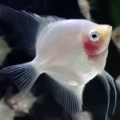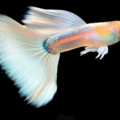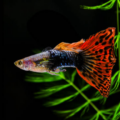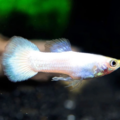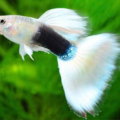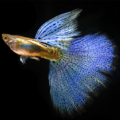Health care, Ideal tank environment, and optimal feeding tips for a long and healthy life for keeping the Snakeskin Guppy in your aquarium.
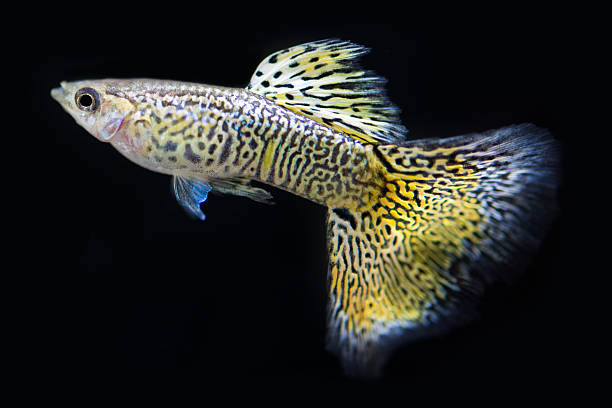
The Mesmerizing World of Snakeskin Guppies
I’ve wanted to bring you this Snakeskin Guppy Overview since I started this series with the Top 20 most popular guppies worldwide, and it’s finally here. This exotic guppy species is beloved for its physical appearance, which resembles a real-life snake’s skin.
If you’re looking for an aquarium showstopper fish, your search is over because the Snakeskin guppy fits the bill. This scale-patterned Guppy has all the attributes of an aquatic star, from its colorful scales to its expressive eyes and social personality.
Stay with me as I show you tips to care for its physical health and internal well-being. Firstly, where did these pretty guppies come from?
Origins and Breeding Development
Ornamental guppy development started in the late 20th century in Asia and Europe, but these variants have since found their way to the United States and other South American countries.
Fish traders looked for ways to isolate their favorite genetic traits in guppies during cross-breeding to create the ultimate guppy fish. And that’s how the Snakeskin Guppy origins started.
As the selective breeding experiments took off, the Snakeskin guppies came out with even more patterns than the breeders expected.
Let’s shine a spotlight on these intricate patterns on the 1 – 2 inches long body of the Snakeskin guppy fish.
Distinctive Physical Characteristics

You already know that snakeskin guppies are popular for their snake-like fish design scales, but you may be wondering if they are worth keeping as pets.
Just like there are varieties of snakeskin patterns, this species also has textured guppy scales with unique designs varying in color and intensity.
Here’s a close look at each physical trait for you:
Coloration
Snakeskin guppies have a vivid coloration that mixes dark and bright tones. They have a dark base with brighter top coats forming spots, swirls, or stripes in yellow, blue, green, and orange.

Fins
Like other wild and ornamental guppies, the Snakeskin variant has a dramatic and elegant tailfin. It’s often translucent despite having a large fan-like shape, which makes it look lightweight and elegant while swimming.
Eyes
You’d love the Snakeskin guppies for their expressive eyes, which light up when they’re excited. Their eyes are often bright colored and bold, so you’ll notice every emotion, and this makes them an ideal interactive species.
The intricate guppy markings on their small, slender bodies with their bright-colored eyes and elegant fins make this species top of the list of ornamental fish. So, how can you preserve these sensitive features?
Essential Care Requirements for Snakeskin Guppies
This essential Snakeskin Guppy care guide lays a foundation for healthy Snakeskin guppies by creating an ideal tank setup. What makes for a perfect aquarium for this species?
Tank Size
Although guppies are typically small, with a full length of 1 – 2 inches and an extra 1 – 2 from their long, elegant fins, they need a large tank for movement. Get a ten-gallon rectangular tank for a school of 5 – 6 Snakeskin guppies and other species.
Water Parameters
Set the water parameters in the tank to mimic that of the Snakeskin guppy’s natural habitat. Here’s a guideline on the ideal parameters:
- Temperature: 75 – 82
- pH level: 6.5 – 8, which is slightly alkaline
- Hardness: 10 – 20 dGH, which is moderately hard and mostly soft.
Once you’ve set the parameters, ensure water stability for guppies by testing your aquarium for sudden spikes in each parameter. Change 25 – 30% of the water every week to prevent bacteria or fungus build-up and maintain its quality.
Quality water has many benefits beyond being a healthy living environment. It’s also great for preserving guppy patterns because your pets are at peace and would grow at a normal pace as though they were in the wild.
Creating the Ideal Tank Setup for Snakeskin Guppies
Your Snakeskin Guppy tank setup isn’t complete without adding a high-quality filtration system, adequate lighting, and using Guppy-friendly tank decor to complete your habitat recreation.
Filtration
After setting your tank water parameters and ensuring a stable condition, you should also add a high-quality filter to the aquarium. Optimal filtration systems help you clean the water of leftover food and dirt while boosting the oxygen distribution in the tank.
If your community is large and dense, you can add air stones to maintain standard oxygen levels in the tank.
Lighting
Your Snakeskin guppies would benefit from smart aquarium lighting techniques like creating a day-to-night cycle and keeping the reflection low to moderately bright. An 8-12 hour cycle helps your pet rest when necessary instead of being active around the clock.
While low to moderate lighting reduces the risk of stress and blindness. You can use your tank decor to shield your pets from direct light reflection.
Decoration
Decorating your Snakeskin Guppy’s tank is fun because there are no strict rules beyond using your imagination to recreate its natural habitat.

Use only Guppy-friendly tank decor when designing your tank’s interior, and by that, I mean soft and fine substrates like smooth sand, pebbles or granite, and other decorative pieces that are gentle on the scales.
Use driftwood and caves in between live plants like Java Moss, Amazon Swords, and Anubias for the tank’s aesthetics.
Covering the tank’s top is necessary because guppies can get excited during feeding sessions and jump out of the aquarium.
Feeding and Nutrition for Snakeskin Guppies
If you want to preserve your Snakeskin Guppy’s glistening patterned scales, you must create a nutrient-rich guppy diet. Feed your pets with all the vitamins and nutrients they’ll need for a healthy life, including color-enhancing fish food with Beta-carotene.
Start the base diet with high-quality flakes and pellets rich in protein and vitamins. Then, supplement the staples with frozen, freeze-dried, or live foods such as Brine Shrimp, Bloodworms, and Daphnia.
Finally, add vegetables like blanched Spinach and Peas to help with their digestion because your Guppy nutrition isn’t complete without fiber for gut health.
For more on feeding your aquatic pets check out The Ultimate Guide to Fish Food: Pros and Cons & Best Choices!
Feeding Schedules
You must have feeding schedules for the times and portions of food you give your Snakeskin Guppy. Feed them only two to three times daily and in quantities they can finish within 3 minutes to prevent waste and overfeeding.
You may also observe your pets and adjust the feeding schedule based on their activities and appetite as long as you don’t risk their health.
Lifespan of Snakeskin Guppies
The Snakeskin Guppy’s lifespan is shorter than that of other ornamental guppies because they live for about 2 – 3 years before completing their cycle. Even the 2 – 3 years isn’t certain unless you prioritize your Snakeskin Guppy health management for lifespan optimization.
Since you’re reading this guide, you’re halfway through your journey to extending Guppy’s life, so let’s finish strong, okay?
Common Health Issues and Prevention Strategies
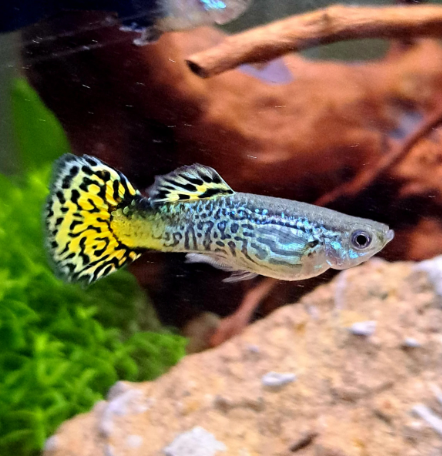
You’ve seen how creating the ideal tank environment is the foundation for preventing fish diseases, but did you know your Snakeskin Guppy can still get ill from genetic predisposition and little mistakes?
Because of their physical traits, you must prioritize certain parts of the Guppy health care when dealing with this species, like choosing fin health preservation over having a diverse community tank.
Choose only tank mates that won’t nip at your Snakeskin Guppy’s fins, and use decor that accommodates its size while swimming. Finally, observe your pets for behavioral changes and signs of distress because illness detection isn’t magic. It’s simply knowing your pets.
Here are some tips to help:
Ich
- Symptoms: Scratching, White Spots on the Scales
- Cause: Bacterial infection
- Treatment: Aquarium salt treatment, Increased Temperature
For more details checkout our article on How to Treat Ich Outbreaks in Your Freshwater Fish!
Fin Rot
- Symptoms: Discolored and Damaged Fins
- Cause: Stress, Poor Diet, Infection
- Treatment: Optimize your Guppy’s diet and use healing creams on the frayed fins
Swim Bladder Disease
- Symptoms: Difficulty in swimming, floating or sinking
- Cause: Overfeeding on Dry Food
- Treatment: Fast your pets for at least a day and increase the vegetables in their diet.
Velvet Disease
- Symptoms: Dusty scales, Laziness, Rubbing against Objects
- Cause: Sudden spikes in water quality, infection from new fish
- Treatment: Change the water quality. Copper-based treatment
Dropsy
- Symptoms: Swollen bodies, Raised Scales, and Laziness
- Cause: Infected tank environment
- Treatment: Improve diet using the guidelines above.
Breeding Snakeskin Guppies: Best Practices
You’re almost a pro at caring for this species, and now it’s time to see how you can join other hobbyists in breeding snakeskin guppies.
The Breeding Pair
There are several ways you can handle breeding for this species, but one common method is selective breeding pairs. Carefully choose your breeders based on their desirable traits, such as scale patterns and colors, size, and temperament.
You’ll notice that the males are larger and more colorful than the females, so ensure you have the right ratio of 1:3 male to female in the tank.
This video has been very helpful in identifying the sex of Guppies, I highly recommend it:
Breeding Tank Setup
It’s time to adopt some pattern-preserving techniques. Keep optimal water conditions with a temperature of 78 – 80℉ and add enough live plants and caves in a separate breeding tank. The hiding spots are good for breeding and spawning.
Spawning Process
The males will display courtship traits by chasing the females to mate with them. After mating, the female Snakeskin guppy will carry her young for 4 – 6 weeks and then give birth to live fry.
Fry Care
Separate the Snakeskin Guppy parent from their new fry to prevent them from eating their young. Then start your Guppy fry care, which includes giving them a specialized diet of crushed flakes, powdered food, infusoria, and baby Brine shrimp.
As they grow older and larger, separate the larger fry from the small ones so they can also develop without getting bullied.
Reintegration
Once your Snakeskin Guppy fry is about 4 to 6 weeks old, it’s time to move them to the main tank. But first, quarantine them in a grow-out tank for two weeks and observe their health before letting them mix with other adults.
Conclusion
I hope you’ve enjoyed this Snakeskin Guppy care summary and agree with me that this species is easy to maintain. Let’s do a quick recap to see if you’ve been following so far:
Adding patterned guppies to your tank requires special care practices. Can you remember them?
- Optimal Water Parameters
- Ideal Tank Environments
- Nutrient-rich diet
- Lifespan-Enhancing practices
These ornamental guppy insights are all you need to have a thriving aquarium filled with the Snakeskin variant and other compatible species. And the best part is that the guppy-friendly decor doesn’t affect your aquarium’s beauty.

